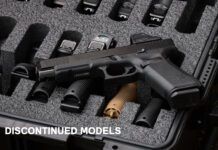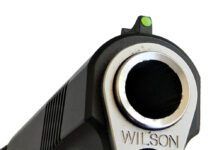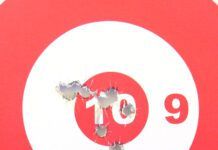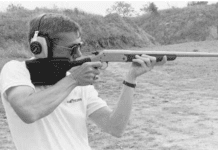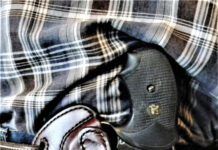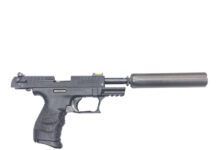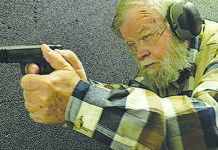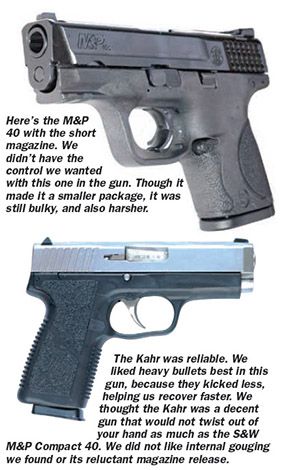
Gun Test’s Idaho test team has spent a lot of time looking at relatively tiny 9mm handguns over the past year. We’ve found there are a few good designs that permit the use of some relatively hot ammo in the small 9mm packages. But some people want still more power, so we’ve decided to sample a few of the forties out there. For this test we looked at a S&W M&P Compact 40 ($569) and a Kahr CW40 ($485). They are a bit larger than the tiny nines we’ve been trying, and there are good reasons for that. The 40 S&W is a lot more cartridge than the 9mm Parabellum, and when forties get smaller than these two test guns, recoil is entirely unfriendly. However, Kahr and a few other makers do offer smaller guns in this caliber if you must have one. We tested these two compact forties with three types of ammo, Remington 155-grain JHP, Black Hills 165-grain JHP, and American Eagle 180-grain FMC. Here’s what we found.
Smith & Wesson M&P 40 Compact No. 109003 40 S&W, $569
Our first impression of the M&P Compact was that, yes, it can fit in a big pocket, but we wouldn’t be completely happy with it there. The grip extension made it hard to get out of the pocket. A suitable concealed-carry holster would be far better, we thought, for packing this amount of powerful handgun. A magazine with a smaller bottom plate came with the gun, as well as some different-size inserts for bigger or smaller hands, but with the smaller magazine in place, we thought the M&P 40 Compact was still a big enough gun that most of us would have preferred to pack it in a holster, especially if we were in a hurry to get the gun out. The same held true for the Kahr CW40. Also, the smaller grip resulting from the flat-bottom mag was not as secure feeling as the larger grip, which permitted getting all our fingers onto the gun.
The fit and finish were excellent, we thought. The pebbly leather feel of the grip was pleasant, but it did not provide enough traction during our shooting. The three-white-dot sights were excellent, giving good visibility and a good sight picture.
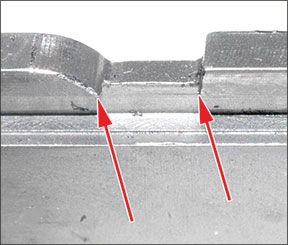
The wavy pattern on the rear of the slide provided plenty of grip to control the slide, which required a strong pull to get all the way back. There was a rail under the chin for a light or laser sight. The sights and trigger were typical Smith & Wesson, which is to say outstanding. The fixed sights had three white dots and gave a good sight picture. We noted the rear sight is a cantilever, made of steel, but when viewed from the side, it has a relatively thin section across its overhang. Can it break if dropped? Most likely it’ll bend, and we’re really picking nits here.
The overall design of the M&P permits easy takedown for maintenance. With the extended magazine, we liked the feel of the gun in the hand very much. With the flat-bottom mag in place, we didn’t like it so much. We test-fired it with the extension magazine, and when we tried it with the other, we didn’t like the control nearly as well.
Takedown for cleaning and maintenance with this design is extremely easy. Clear the gun, lock the slide back and turn that lever on the left side downward 90 degrees. Release the slide, press the trigger, and pull the slide off the frame. The captive spring comes easily out and so does the barrel. Reassembly was just as easy. Inside the gun, the use of stampings and clever engineering were obvious. As always, we were impressed with the construction and engineering of the M&P that results in simple, easily made parts inside that might look on the small side, but are more than strong enough for anything asked of them. We liked this gun’s design as much as we liked its feel and operation.
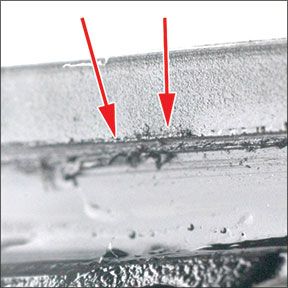
The M&P’s trigger was relatively predictable and controllable. However, the M&P 40 Compact kicked quite hard. The recoil was, we thought, unlike the push of the average 45 ACP round, but more of a vicious snap. The gun twisted badly in our hands, and we concluded some additional traction on the front and rear straps was needed. Grooves, checkering, or stippling there would greatly help the control. The leather-like covering of the polymer frame did not lend itself to being sticky, which was not a good thing. On firing the hotter rounds for accuracy, the gun twisted badly in our hands no matter how hard we held it, and we had to reposition our grip every time for the next shot. During rapid-fire testing it was less of a problem because we were not concerned with extreme accuracy. But be advised, there’s significant kick to these 40-caliber guns. The two hot light-bullet loads were also quite loud.
Accuracy was adequate, but there was no tack driving. The gun seemed to like the heavier bullets more, and so did we, because they were not as brutal as the lighter JHP loads. The full-metal-jacket bullets in several brands we’ve seen in 40 S&W caliber are truncated cones, flat noses with full metal covering. That design has been lauded by several sources as being excellent for self defense. Such a design would seem to be lots better than just a round nose, as found on most other hardball ammunition in other calibers.
Our Team Said: This was an excellent handgun if you need a compact 40-caliber semiauto. Our one complaint was that the grips needed more traction on the forward and rearmost parts. If you need a compact but perhaps not quite pocket-size 40, we thought this was an excellent choice. It’s an A-minus in our book.
Kahr CW40 No. CW4043 40 S&W, $485
Our first meeting with the CW40 Kahr was relatively pleasant. The look of the gun was businesslike, with a similarity to the look of other Kahr handguns. The left side of the matte-white slide told us the model and maker. There were no markings on the right. The grip frame had coarse, ratchet-like serrations on the front and rear strap. These were grooved horizontally and stepped vertically along each row to the sides of the grip. We quickly found out that while this was superior to the traction on the S&W M&P, we would have preferred the open grooves to be vertical. Turn the artificial roughness 90 degrees and you’ve got it, Mr. Kahr. The grip felt great as to its shape and size. Though the gun was a bit top heavy, the good full-hand grip we could get on the frame made that not a problem.
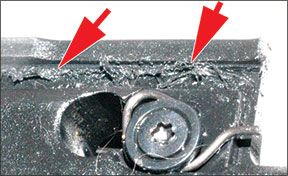
A few of us thought the trigger was a bit too curved, with its tip gouging the tip of our finger. But it was nothing like the Kel-Tec P11 we tested a while back. We thought the slide was extremely well made, inside and out. Like the Smith & Wesson, the Kahr had an internal safety plunger that prevented the firing pin from moving forward until the trigger was pressed. So if the guns are dropped, despite having no external safety levers, they can’t fire. Modern designs like these two make good use of coil springs. The M&P had one in tension for the trigger return, and the Kahr has a hairpin spring wound around the trigger axle to give it its tension.
Takedown was a bit more complex than for the M&P. After clearing the gun, line up two marks on the left side of the slide and frame, and tap the crosspin out to the left. Or pry it out with a screwdriver, keeping the marks lined up. With the cross pin, which is the slide stop, out of the gun, move the slide forward while pressing the trigger, and off it comes. The spring can then be removed carefully to avoid zinging the guide rod into your eye, and out comes the barrel. Reassembly was not too easy because getting the recoil spring back in took great strength and dexterity. Getting the slide-lock pin back in was easier, because there was no need to line up the two marks until after you’ve got the pin partway into the gun.
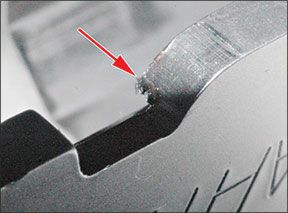
On the range we found the six-round magazines were not that easy to load. They required a strong push against a stiff spring. We also found the gun to be something of a handful, just as the S&W had been, but the Kahr was somewhat easier to hold on target after each shot. Our two hottest loads made significant noise and caused the gun to try to twist in the hand, like the M&P had done, but the serrations on front and back straps helped us keep the Kahr CW40 lined up properly. Still, we’d like even more traction there.
Like the S&W, the Kahr did not show a lot of accuracy. However, it hit where it looked for the most part, and we were able to hit can-size targets offhand with relative ease from 10 or 15 yards. Both guns could group about 3 inches at 15 yards. We thought they both had enough accuracy for any reasonable purpose. However, we thought the Kahr’s trigger was so unusual that it’ll require lots of time to get accustomed to it. A very long pull resulted in a hesitation just before break, and then came the break, which was smooth enough and quite controllable if you knew where it was. Yet it was unlike most other triggers, so be aware of that. If you have to switch guns for any reason, it’s a good idea to have similar triggers on all your guns to avoid unwanted discharges or, on the other side of the coin, missed shots from not hauling on the trigger hard or long enough.
After our initial testing, inside the Kahr we found some fibrous particles in the left raceway of the plastic frame, where the slide rides. They looked like bits of polymer. We inspected the slide and found a sharp edge that could have been shaving the frame. We noted there is apparently no steel within the frame at the location of the front of the rails, so any cutting or wear there would not be good for the life of the gun. We also found a razor-sharp edge on the barrel next to the chamber, and when we say razor sharp we’re not exaggerating. There were also burrs on the unfinished square edges at the top rear of the barrel. Although the gun fed, fired, and ejected perfectly during our testing, we’d remove those sharp edges because we don’t like to bleed while cleaning our guns. The back of the chamber and the feed ramp were mirror polished, a nice touch.
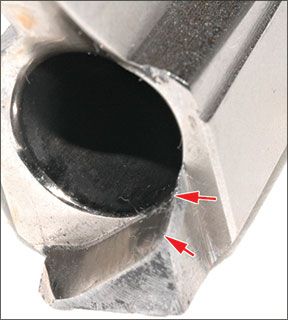
To see if there was a problem with continued cutting or gouging of the frame, we put some Slide Glide (BrianEnos.com) onto the rail guides and ran some more ammo through the CW40. On inspection, we found what appeared to be a slight bit of additional gouging of the frame by the slide. We don’t like that. We found a sharp spot in the slide that could result in cutting the frame like a shaper, slowly removing a layer of plastic with every cycle of the slide. On close inspection it looked like a bit of the black plastic frame had been shaved off and stuck to the front edge of that sharp notch in the slide.
Our Team Said: The Kahr was reliable during all our testing. However, we had a hard time getting the magazines out some of the time. The release button required complete submersion into the frame. We were not comfortable with that, and it was inconsistent. We liked the heavy bullets best because they kicked less, and we could thus recover faster between shots. We thought the Kahr was a decent gun that would set you back a bit less than the M&P, and would not tend to twist out of your hand quite as much. We did not like the internal gouging or the reluctant magazine release. Therefore, we gave the Kahr a B grade. From the limited testing we did, we thought we could pick either of these guns and be happy, but believe we’d be happier longer with the S&W M&P Compact 40, despite its costing us about $85 more.
Written and photographed by Ray Ordorica, using evaluations from Gun Tests team testers. GT


